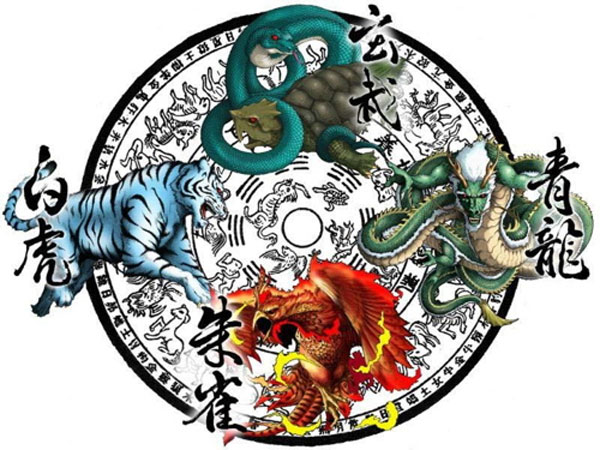By lyuesword | 14 May 2021 | 1 Comments
Mythology of The Four Divine Beasts
The Four Symbols (Chinese: 四象; pinyin: Sì Xiàng, literally meaning "four images"), are four mythological creatures appearing among the Chinese constellations along the ecliptic, and viewed as the guardians of the four cardinal directions. These four creatures are also referred to by a variety of other names, including "Four Guardians", "Four Gods", and "Four Auspicious Beasts".
Each of the creatures is most closely associated with a cardinal direction and a color, but also additionally represents other aspects, including a season of the year, a virtue, and one of the Chinese "five components" (wood, fire, earth, metal, and water). Each has been given its own individual traits and origin story. Symbolically, and as part of spiritual and religious belief, these creatures have been culturally important across countries in the East Asian cultural sphere.
Azure Dragon (青龙 qīnglóng) – represents the East, Spring, and the Wood.
White Tiger (白虎 báihǔ) – represents the West, Autumn, and the Metal.
Black Tortoise (玄武 xuánwǔ) – represents the North, Winter, and the Water. It’s also known as the Turtle-Snake (龟蛇), and it looks like a tortoise entwined with a snake. The Black Tortoise is closely connected to the warrior god Xuanwu.
Vermilion Bird (朱雀 zhūquè) – represents the South, Summer, and the Fire. It looks like a red pheasant, although sometimes it’s depicted with multi-colored plumage.

History
Depictions of mythological creatures clearly ancestral to the modern set of four creatures have been found throughout China. Currently, the oldest known depiction was found in 1987 in a tomb in Xishuipo (西水坡) in Puyang, Henan, which has been dated to approximately 5300 BC. In the tomb, labeled M45, immediately adjacent to the remains of the main occupant to the east and west were found mosaics made of clam shells and bones forming images closely resembling the Azure Dragon and White Tiger, respectively.
The modern standard configuration was settled much later, with variations appearing throughout Chinese history. For example, the Rongcheng Shi manuscript recovered in 1994, which dates to the Warring States Period (ca. 453–221 BCE), gives five directions rather than four and places the animals differently. According to that document, Yu the Great gave directional banners to his people, marked with the following insignia: the north with a bird, the south with a snake, the east with the sun, the west with the moon, and the center with a bear.
In Taoism, the Four Symbols have been assigned human identities and names. The Azure Dragon is named Meng Zhang (孟章), the Vermilion Bird is called Ling Guang (陵光), the White Tiger Jian Bing (監兵), and the Black Tortoise Zhi Ming (執明).
The colours associated with the four creatures can be said to match the colours of soil in the corresponding areas of China: the bluish-grey water-logged soils of the east, the reddish iron-rich soils of the south, the whitish saline soils of the western deserts, the black organic-rich soils of the north, and the yellow soils from the central loess plateau.
Want a unique sword? Feel free to contact us:
Email: lyuesword@hotmail.com
Website: www.lyuesword.com
Custom Sword Page: www.lyuesword.com/Custom-Sword/customization-options/Create-Your-Own-Swords
Each of the creatures is most closely associated with a cardinal direction and a color, but also additionally represents other aspects, including a season of the year, a virtue, and one of the Chinese "five components" (wood, fire, earth, metal, and water). Each has been given its own individual traits and origin story. Symbolically, and as part of spiritual and religious belief, these creatures have been culturally important across countries in the East Asian cultural sphere.
Azure Dragon (青龙 qīnglóng) – represents the East, Spring, and the Wood.
White Tiger (白虎 báihǔ) – represents the West, Autumn, and the Metal.
Black Tortoise (玄武 xuánwǔ) – represents the North, Winter, and the Water. It’s also known as the Turtle-Snake (龟蛇), and it looks like a tortoise entwined with a snake. The Black Tortoise is closely connected to the warrior god Xuanwu.
Vermilion Bird (朱雀 zhūquè) – represents the South, Summer, and the Fire. It looks like a red pheasant, although sometimes it’s depicted with multi-colored plumage.

History
Depictions of mythological creatures clearly ancestral to the modern set of four creatures have been found throughout China. Currently, the oldest known depiction was found in 1987 in a tomb in Xishuipo (西水坡) in Puyang, Henan, which has been dated to approximately 5300 BC. In the tomb, labeled M45, immediately adjacent to the remains of the main occupant to the east and west were found mosaics made of clam shells and bones forming images closely resembling the Azure Dragon and White Tiger, respectively.
The modern standard configuration was settled much later, with variations appearing throughout Chinese history. For example, the Rongcheng Shi manuscript recovered in 1994, which dates to the Warring States Period (ca. 453–221 BCE), gives five directions rather than four and places the animals differently. According to that document, Yu the Great gave directional banners to his people, marked with the following insignia: the north with a bird, the south with a snake, the east with the sun, the west with the moon, and the center with a bear.
In Taoism, the Four Symbols have been assigned human identities and names. The Azure Dragon is named Meng Zhang (孟章), the Vermilion Bird is called Ling Guang (陵光), the White Tiger Jian Bing (監兵), and the Black Tortoise Zhi Ming (執明).
The colours associated with the four creatures can be said to match the colours of soil in the corresponding areas of China: the bluish-grey water-logged soils of the east, the reddish iron-rich soils of the south, the whitish saline soils of the western deserts, the black organic-rich soils of the north, and the yellow soils from the central loess plateau.
Want a unique sword? Feel free to contact us:
Email: lyuesword@hotmail.com
Website: www.lyuesword.com
Custom Sword Page: www.lyuesword.com/Custom-Sword/customization-options/Create-Your-Own-Swords
Recently Reviews
Read MoreLeave a Reply
Your email address will not be published.Required fields are marked. *